A sword is an edged, bladed weapon intended for manual cutting or thrusting. Its blade, longer than a knife or dagger, is attached to a hilt and can be straight or curved. A thrusting sword tends to have a straighter blade with a pointed tip. A slashing sword is more likely to be curved and to have a sharpened cutting edge on one or both sides of the blade. Many swords are designed for both thrusting and slashing. The precise definition of a sword varies by historical epoch and geographic region.
A tsurugi (剣) or ken (剣) is a Japanese sword. The word is used in the West to refer to a specific type of Japanese straight, double-edged sword used in antiquity. In Japanese the term tsurugi or ken is used as a term for all sorts of international long, double-edged swords.
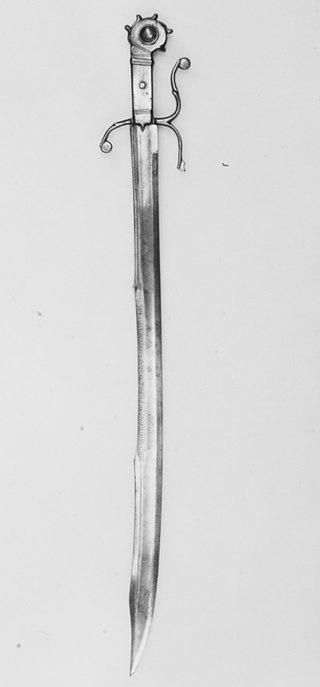
A falchion is a one-handed, single-edged sword of European origin. Falchions are found in different forms from around the 13th century up to and including the 16th century. In some versions, the falchion looks rather like the seax and later the sabre, and in other versions more like a machete with a crossguard.
This is a list of types of swords.

A blade is the portion of a tool, weapon, or machine with an edge that is designed to puncture, chop, slice or scrape surfaces or materials. Blades are typically made from materials that are harder than those they are to be used on. Historically, humans have made blades from flaking stones such as flint or obsidian, and from various metal such as copper, bronze, and iron. Modern blades are often made of steel or ceramic. Blades are one of humanity's oldest tools, and continue to be used for combat, food preparation, and other purposes.

A razor is a bladed tool primarily used in the removal of body hair through the act of shaving. Kinds of razors include straight razors, safety razors, disposable razors, and electric razors.

Swordsmanship or sword fighting refers to the skills and techniques used in combat and training with any type of sword. The term is modern, and as such was mainly used to refer to smallsword fencing, but by extension it can also be applied to any martial art involving the use of a sword. The formation of the English word "swordsman" is parallel to the Latin word gladiator, a term for the professional fighters who fought against each other and a variety of other foes for the entertainment of spectators in the Roman Empire. The word gladiator itself comes from the Latin word gladius, which is a type of sword.

The English language terminology used in the classification of swords is imprecise and has varied widely over time. There is no historical dictionary for the universal names, classification, or terminology of swords; a sword was simply a single-edged or double-edged knife.
The traditions of Korean bladesmithing and swordsmanship have served a central place in the military history of Korea for thousands of years. Although typical Korean land battles have taken place in wide valleys and narrow mountain passes, which favor use of spears and bows, the sword found use as a secondary, close-quarters weapon, in addition to far more prominent role during sieges and ship-to-ship boarding actions. Higher quality, ceremonial swords were typically reserved for the officer corps as a symbol of authority with which to command the troops. Ceremonial swords are still granted to military officials by the civilian authority to this day.
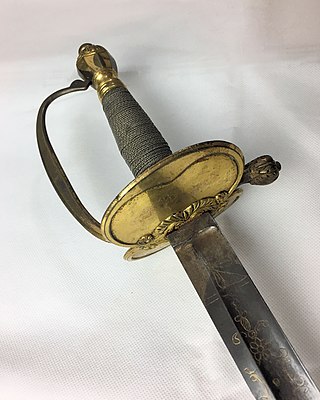
A spadroon is a light sword with a straight-edged blade, enabling both cut and thrust attacks. This English term first came into use in the early 18th century, though the type of sword it referred to was in common usage during the late 17th century. They were primarily used as a military sidearm in the late 17th and early 18th centuries, and for officers and NCOs in the latter part of the 18th and early 19th centuries. The type of sword also saw widespread use across Europe and America, though the term 'spadroon' is unique to the Anglophone world.

A kalis is a type of Philippine sword. The kalis has a double-edged blade, which is commonly straight from the tip but wavy near the handle. Kalis exists in several variants, either with a fully straight or fully wavy blade. It is similar to the Javanese keris, but differs in that the kalis is a sword, not a dagger. It is much larger than the keris and has a straight or slightly curved hilt, making it a primarily heavy slashing weapon.
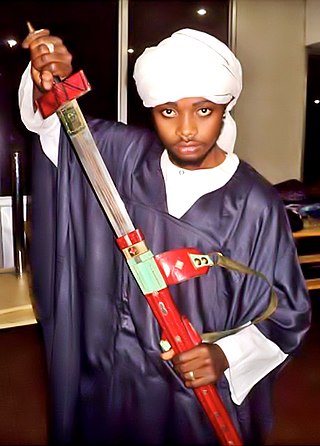
Takoba is the sword that is used across the western Sahel and among ethnic groups such as the Tuareg, the Hausa, and the Fulani. It usually measures about one meter in length. Takoba blades are straight and double edged with a pronounced tapering from the guard towards the tip; they can exhibit several notable features, including three or more hand-ground fuller grooves and a rounded point.
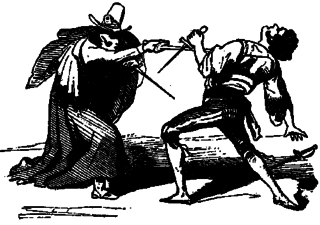
The parrying dagger is a category of small handheld weapons from the European late Middle Ages and early Renaissance. These weapons were used as off-hand weapons in conjunction with a single-handed sword such as a rapier. As the name implies they were designed to parry, or defend, more effectively than a simple dagger form, typically incorporating a wider guard, and often some other defensive features to better protect the hand as well. They may also be used for attack if an opportunity arises. The general category includes two more specific types, the sword breaker and trident dagger.
The Yanmaodao is a type of dao used as a standard military weapon during the Ming Dynasty and middle Qing Dynasty (1368–1800). The blade is straight until the curve begins around the center of percussion along the last 1/4 or so of the blade approaching the tip. The center of percussion is the point on the blade with the least vibration on hard contact, the spot on the blade that transmits the most power to the target in a hard chop. This allows for thrusting attacks and overall handling similar to that of the jian, while still preserving much of the dao's strengths in cutting and slashing. This type of sword seems to have lost its popularity with military and martial arts practitioners alike by the end of the 18th century.

A scimitar is a single-edged sword with a convex curved blade associated with Middle Eastern, South Asian, or North African cultures. A European term, scimitar does not refer to one specific sword type, but an assortment of different Eastern curved swords inspired by types introduced to the Middle East by Central Asian ghilmans. These swords include the Persian shamshir, the Arab saif, the Indian talwar, the North African nimcha, and the Turkish kilij. All such swords are originally derived from earlier curved swords developed in Turkic Central Asia (Turkestan).

The basket-hilted sword is a sword type of the early modern era characterised by a basket-shaped guard that protects the hand. The basket hilt is a development of the quillons added to swords' crossguards since the Late Middle Ages. In modern times, this variety of sword is also sometimes referred to as the broadsword.
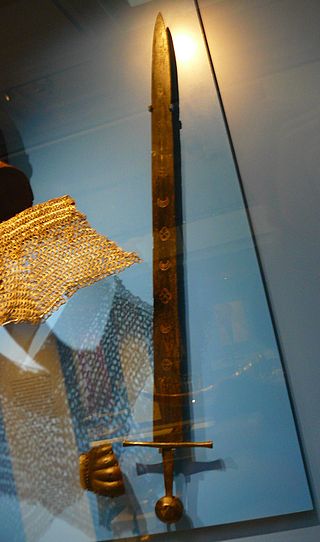
In the European High Middle Ages, the typical sword was a straight, double-edged weapon with a single-handed, cruciform hilt and a blade length of about 70 to 80 centimetres. This type is frequently depicted in period artwork, and numerous examples have been preserved archaeologically.
There are two notable swords known recovered from the River Witham, both kept in the British Museum.

The Saif, sometimes called a shamshir, depending on the era, originated in Arabia before the 7th century. Little is known about this weapon besides what Al-Kindi wrote in his treatise On Swords in the 9th century.

The Turco-Mongol sabre, alternatively known as the Eurasian sabre or nomadic sabre, was a type of sword used by a variety of nomadic peoples of the Eurasian steppes, including Turkic and Mongolic groups, primarily between the 8th and 14th centuries. One of the earliest recorded sabres of this type was recovered from an Avar grave in Romania dating to the mid-7th century.















